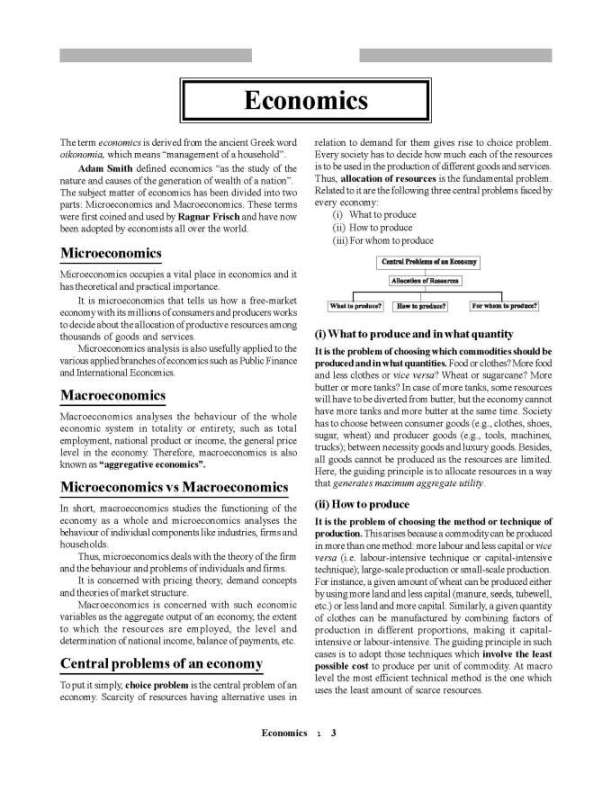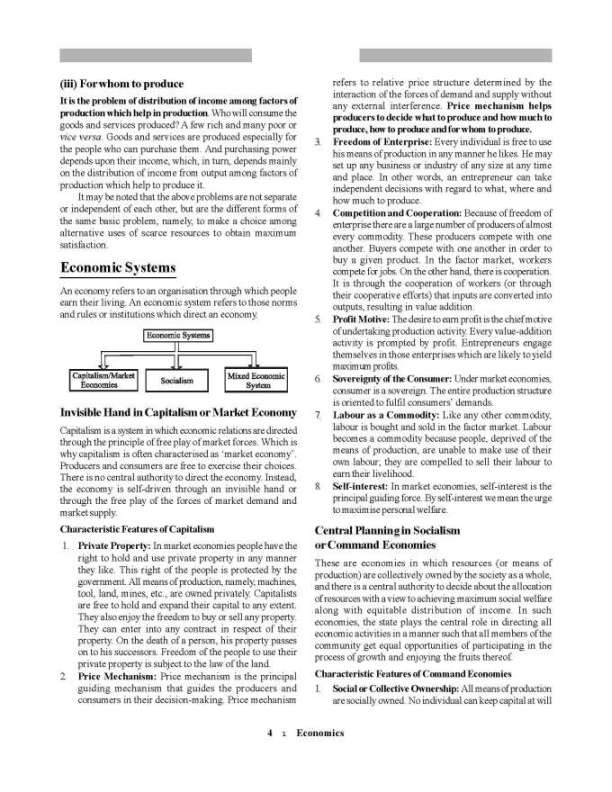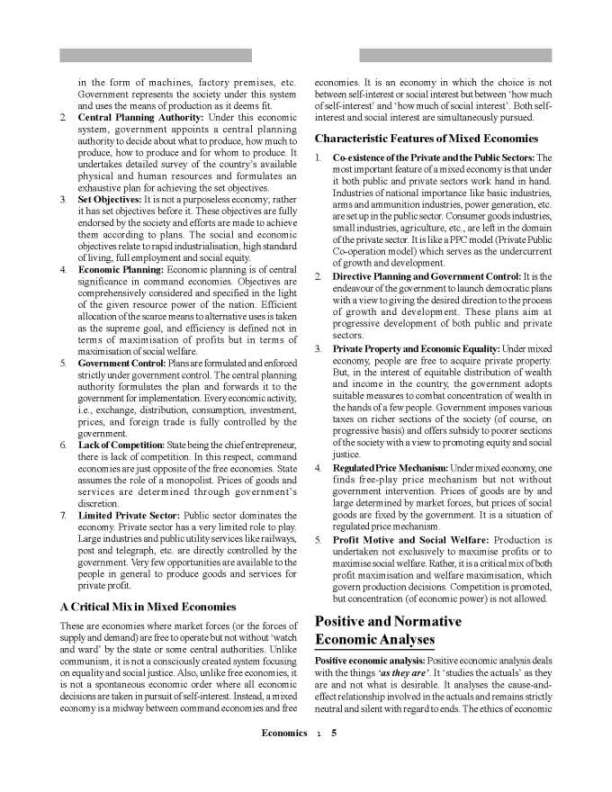|
#3
9th May 2020, 01:08 PM
| |||
| |||
| Re: SSC Economics Notes Pdf Economics Notes     Important Questions for SSC CGL exam Q1. The process of curing inflation by reducing money supply is called (a) Cost-push inflation (b) Demand-pull inflation (c) Disinflation (d) Reflation Q2. Indian agriculture is typically characterized as (a) land surplus, labour scarce economy (b) land surplus, labour surplus economy (c) land scarce, labour surplus economy (d) land scarce, labour scarce economy Q3. Which of the following items is a major item of Indian export? (a) Computer chips (b) Potato chips (c) Textile garments (d) Car engines Q4. Price theory is also known as (a) Macro (b) Development (c) Public (d) Micro Q5. Which of the statements is correct about India’s national income? (a) Percentage share of agriculture is higher than services (b) Percentage share of industry is higher than agriculture (c) Percentage share of services is higher than industry (d) Percentage share of services is higher than agriculture and industry put together Q6. The gradation and standardization of agricultural products are conducted through (a) Food Corporation of India (b) Directorate of Marketing and Inspection (c) Indian Standards Institution (d) Central Statistical Organization Q7. When too much money is chasing too few goods, the situation is (a) Deflation (b) Inflation (c) Recession (d) Stagflation Q8. One of the main factors that led to rapid expansion of Indian exports is (a) Imposition of import duties (b) Liberalization of the economy (c) Recession in other countries (d) Diversification of exports Q9. Cheap money means (a) Low rates of interest (b) Low level of saving (c) Low level of income (d) Low level of standard of living. Q10. Compared to the rich the poor save (a) A larger part of their income (b) An equal part of their income (c) A smaller part of their income (d) All of their incomes Q11. Kisan Credit Card scheme was introduced in (a) 1991 (b) 1996 (c) 1998 (d) 2000 Q12. Government takes ‘ways and means advances’ from (a) RBI (b) IDBI (c) SBI (d) ICICI Q13. ‘NABARD’ is associated with the development of (a) agricultural sector and rural areas (b) heavy industries (c) banking sector (d) real estates Q14. The permission given to a bank customer to draw cheques in excess of his current account balance is called (a) a personal loan (b) an ordinary loan (c) discounting a bill of exchange (d) an overdraft Q15. Which of the following taxes is not collected by the Central Government? (a) Income tax (b) Customs duty (c) Professional tax (d) Excise duty Q16. Tire supply of agricultural products is generally Important Questions by pinnacle (a) elastic (b) inelastic (c) perfectly elastic (d) perfectly inelastic Q17. With which form of economy is the term ‘Laissez-faire’ associated? (a) Capitalist economy (b) Socialist economy (c) Mixed economy (d) Command economy Q18. When the total product rises at an increasing rate, the (a) marginal product is zero (b) marginal product is rising (c) marginal product is falling (d) marginal product remains constant Q19. The definition of ‘small-scale industry’ in India is based on (a) sales by the unit (b) Investment in machines and equipments (c) market coverage (d) export capacity Q20. Economies of Scale means reduction in (a) unit cost of production (b) unit cost of distribution (c) total cost of production (d) total cost of distribution Q21. Free Trade refers to (a) free movement of goods from one country to another (b) movement of goods free of cost (c) unrestricted exchange of goods and service (d) trade free of duty Q22. Imputed gross rent of owner occupied buildings is a part of (a) capital formation (b) final consumption (c) intermediate consumption (d) consumer durable Q23. Purchasing Power Parity theory is related with (a) Interest rate (b) Bank rate (c) Wage rate (d) Exchange rate Q24. Excise duty on a commodity is payable with reference to its (a) production (b) production and sale (c) production and transportation (d) production, transportation and sale Q25. Knowledge, technical skill, education etc. in , are regarded as (a) social-overhead capital (b) human capital (c) tangible physical capital (d) working capital Q26. Which is the most essential function of an entrepreneur ? (a) Supervision (b) Management (c) Marketing (d) Risk bearing Q27. Bank Rate refers to the Interest rate at which (a) Commercial banks receive deposits from the public (b) Central bank gives loans to Commercial banks (c) Government loans are floated (d) Commercial banks grant loans to their customers Q28. All of the goods which are scarce and limited in supply are called (a) Luxury goods (b) Expensive goods (c) Capital goods (d) Economic goods Q29. Which of the following is a better measurement of Economic Development? (a) GDP (b) Disposable income (c) NNP (d) Per capita income Q30. Foreign currency which has a tendency of quick migration is called (a) Scarce currency (b) Soft currency (c) Gold currency (d) Hot currency Q31. In India, disguised unemployment is generally observed in (a) the Agricultural sector (b) the Factory sector (c) the Service sector (d) All these sectors Q32. The demand curve for a Giffen good is (a) upward rising (b) downward falling (c) parallel to the quantity axis (d) parallel to the price axis Q33. “Supply creates its own demand” – Who said this ? (a) J. B. Say (b) J.S. Mill (c) J. M. Keynes (d) Senior Q34. Engel’s Law states the relationship between (a) quantity demanded and price of a commodity (b) quantity demanded and price of substitutes (c) quantity demanded and tastes of the consumers (d) quantity demanded and income of the consumers Q35. Which one of the following items is not included in the current account of India’s Balance of Payments ? (a) Short-term commercial borrowings (b) Non-monetary gold movements (c) Investment income (d) Transfer payments Q36. Capital : Output Ratio of a measures (a) its per unit cost of production (b) the amount of capital invested per unit of output (c) the ratio of capital depreciation to quantity of output (d) the ratio of working capital employed to quantity of output Q37. ‘The national income consists of a collection of goods and services reduced to common basis by being measured in terms of money.”— Who says this? (a) Samuelson (b) Kuznets (c) Hicks (d) Pigou Q38. What does ECS in banking transactions stand for? (a) Excess Credit Supervisor (b) Extra Cash Status (c) Exchange Clearing Standard (d) Electronic Clearing Service Q39. Which of the following is the classification of Industries on the basis of raw-materials? (a) Small Scale -Large scale (b) Primary and Secondary (c) Basic and Consumer (d) Agro-based and Mineral based Q40. Who propounded the ‘market law? (a) Adam Smith (b) J.B. Say (c) T.R. Malthus (d) David Recardo Q41. The practice of selling goods in a foreign country at a price below their domestic selling price is called (a) ‘diplomacy’ (b) ‘discrimination’ (c) ‘dumping’ (d) ‘double pricing Q42. An expenditure that has been made and cannot be recovered is called (a) Variable cost (b) Opportunity cost (c) Sunk cost (d) Operational cost Q43. Bank deposits that can be withdrawn without notice are called (a) account payee deposits (b) fixed deposits (c) variable deposits (d) demand deposits Q44. New capital issue is placed in (a) Secondary market (b) Grey market (c) Primary market (d) Black market Q45. Prime cost is equal to (a) Variable cost plus administrative cost (b) Variable cost plus fixed costs (c) Variable cost only (d) Fixed cost only Q46. If the tax rate increases with the higher level of income, it shall be called (a) Proportional tax (b) Progressive tax (c) Lump sum tax (d) Regressive tax Q47. Capital formation in an economy depends on (a) Total Income (b) Total demand (c) Total savings (d) Total production Q48. Industrial exit policy means (a) forcing foreign companies to leave India (b) forcing business units to move out of congested localities (c) allowing manufacturers to shift their line of products (d) allowing business units to dose down Q49. Which of the following does not determine supply of labour? (a) Size and age-structure of population (b) Nature of work (c) Marginal productivity of labour (d) Work-leisure ratio Q50. if the price of tea fails, demand for coffee will (a) increase (b) decrease (c) remain same (d) None of these |
